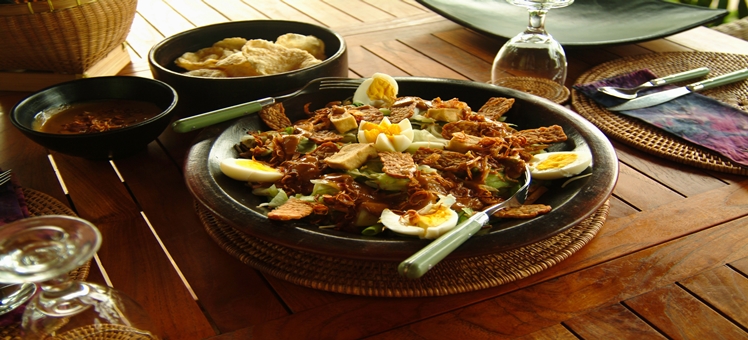
Light, fragrant and infused with a gentle mix of local spices, eating in Bali is a cultural experience. A fraction of the price compared to western food, small rice-based and seafood dishes are affordable staples found in abundance. Authentic Balinese food is a little harder to come by, however, with most local eateries and warungs (cafes) serving Chinese, Indonesian or Halal cuisine from Sumatra.
Eating together in Bali is a rare occasion, with most locals preferring to eat on the go. On a sacred day, however, dining transforms into a social event whereby local dishes such as Babi Guling (suckling pig) and Sate Lilit (seafood sate) are specially prepared and enjoyed as a community. Ingredients commonly used within Balinese cooking include fish pate, palm sugar, chili and root ginger, mixed together to form an authentic concoction of local flavors.
Rubbed with spices and spit-roasted whole, suckling pig is somewhat of a specialty in Bali. Known locally as Babi Guling, this slow-cooked dish is typically infused with coriander, lemongrass, black pepper and garlic and found in the warungs of Ubud.
Restaurants
Today, dining in Bali can be a global experience, with countless restaurants offering a wide variety of international cuisine. Being so close in geographical proximity, Thai, Indian Chinese, Japanese and Australian gastronomy have all become popular on the island. Western food has also started to see a rise in recent years, with French and Italian food reaching many of the resorts and restaurants. Unsurprisingly, however, freshly caught fish and seafood continues to dominate most of the menus along all beachside restaurants and bars.
Warungs
Street-side food stalls or tiny family owned snack bars, Warungs are great for grabbing food on the go. With a mixture of Asian and western food on the menu such as grilled fish, sandwiches, soups and fried rice, these hawker style venues are ideal for helping budget backpackers to keep the costs down. Warungs are located all over the island; however, you will find a strong concentration of them in the Ubud area. Of all the warungs, Warung Babi Guling Ibu Oka - located in the middle of downtown Ubud – is one of the most popular spots. Here you will find mouthwatering slices of roast suckling pig for a mere Rp7,000 m per helping.
• Warung Babi Guling Ibu Oka, Jl Tegal Sari No2, Bali, Indonesia
Night Markets
At night, Bali transforms into a bazaar of bustling street vendors selling all kinds of wares. While handcrafted goods and locally-sourced art feature prominently at these markets, food is also high up on the agenda. Gianyar night market, located just 10 kilometers northeast of Ubud, is one such place. Tempting you with competing smells of sweet cakes, fried bananas and flaked coconut, Gianyar jostles with local life and offers a window into the authentic spirit of Bali.
• Gianyar Night Market, Main Street, Bali, Indonesia
Fine Dining
On the opposite end of the spectrum, Bali has seen a rapid growth in its fine dining scene. As innovative dishes spread across the island, relocated chefs have brought with them a distinctly new set of flavours. With Australian, Japanese and French influence all thrown into the mix, unique dishes such as saffron crab bisque, blackened mahi mahi and prawn gyoza have begun to be feature on showcase menus such as Sardine, a restaurant with its own private rice paddy and lily pond surroundings.
• Sardine, Jalan Petitenget, Kerobokan, +62 361 738 202